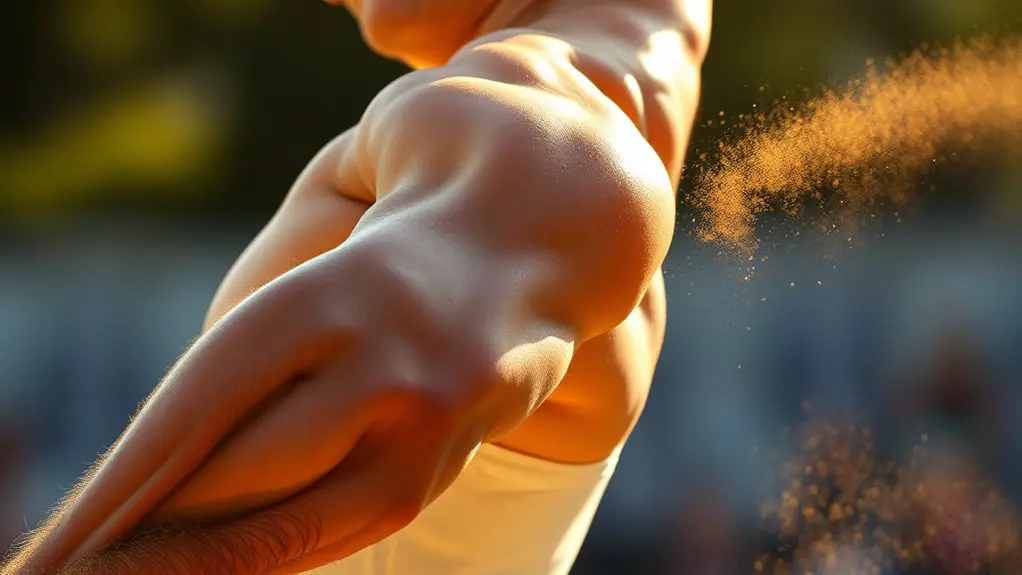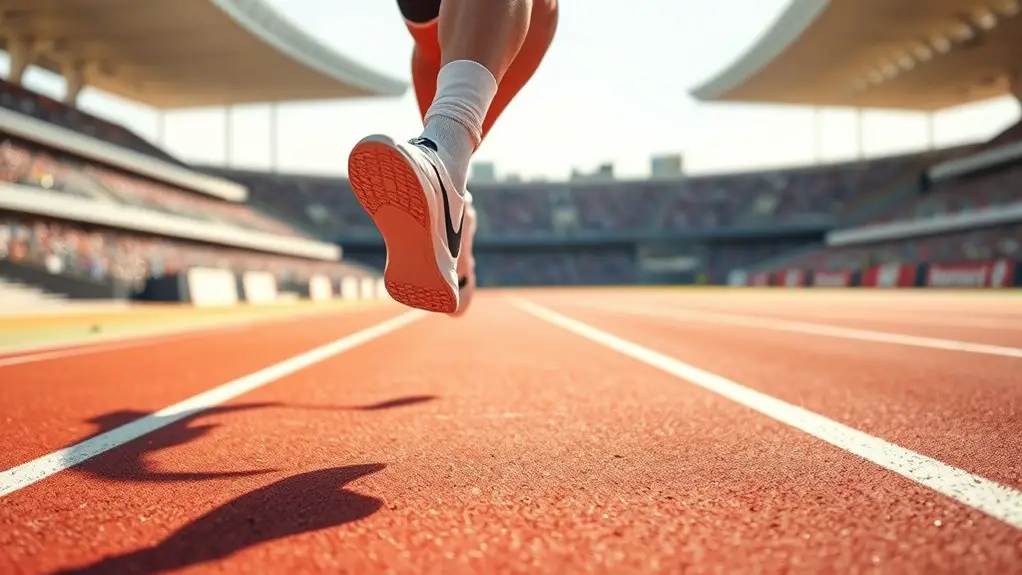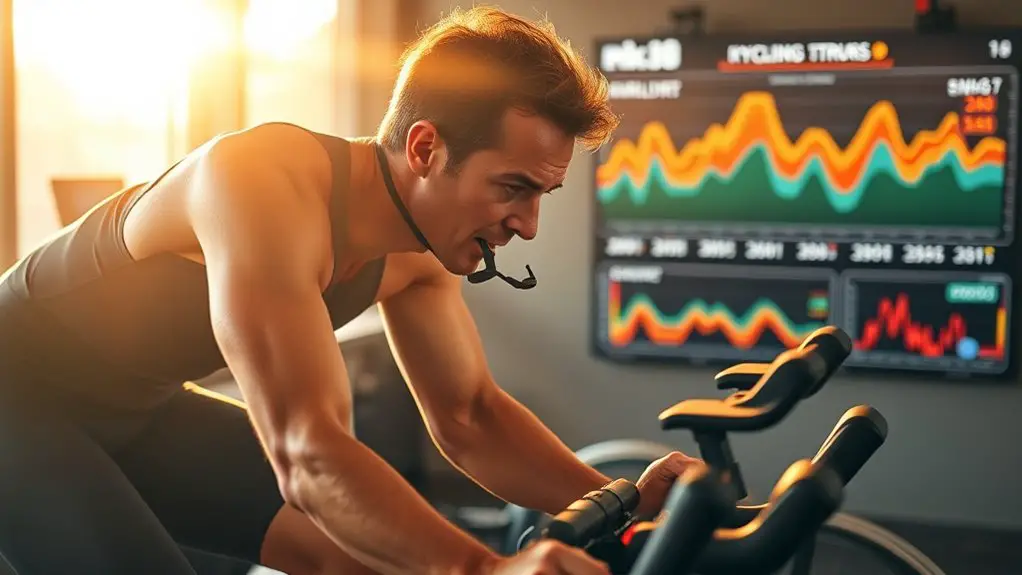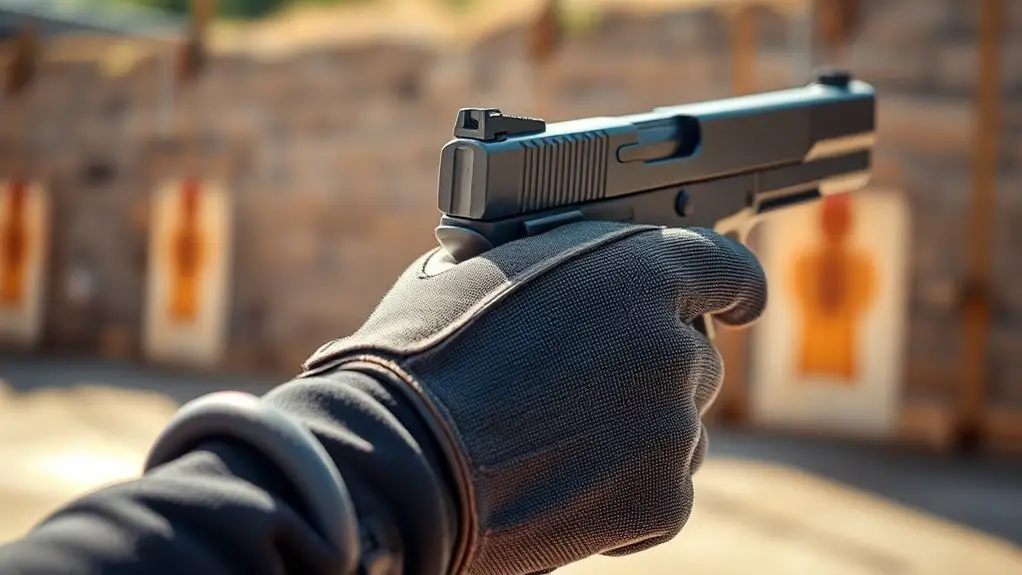To strengthen your shoulder for fast bowling, focus on exercises that target the rotator cuff and scapular stability. Incorporate external and internal rotations with resistance bands, along with scapular retractions. It's also important to include strength training for your deltoids and a routine that enhances your mobility and flexibility. Proper nutrition and monitoring your progress will support recovery and performance. Keep practicing these strategies, and you'll discover even more ways to boost your bowling game.
Understanding Shoulder Anatomy and Function in Fast Bowling
The shoulder is a complex joint essential for fast bowling, playing an important role in generating speed and accuracy. Understanding shoulder biomechanics is key to refining your bowling technique. The shoulder consists of several muscles, tendons, and ligaments that work together, allowing for a wide range of motion. When you bowl, your shoulder's rotator cuff stabilizes the joint while powerful muscles, like the deltoids and pectorals, generate force.
To bowl effectively, you need to coordinate movements from your legs through your core and into your shoulder. This seamless integration helps you release your full potential on the field. By focusing on proper form and technique, you can enhance your performance while minimizing strain on your shoulder. Remember, a well-conditioned shoulder not only boosts your bowling capabilities but also gives you the freedom to express your unique style on the pitch. Embrace the journey of mastering your craft! Additionally, incorporating rotator cuff strengthening exercises can significantly improve your shoulder stability and performance.
Common Shoulder Injuries Among Fast Bowlers
As a fast bowler, you're at risk for several shoulder injuries that can impact your performance. Rotator cuff tears and shoulder impingement syndrome are two common issues that can arise from the repetitive stress of bowling. Understanding these injuries can help you take steps to prevent them and keep your shoulder strong. Incorporating proper warm-ups into your routine is essential for minimizing the risk of shoulder injuries.
Rotator Cuff Tears
While fast bowlers are known for their explosive arm movements, they often put themselves at risk for rotator cuff tears, one of the most common shoulder injuries in the sport. Understanding the rotator cuff anatomy is essential for injury prevention. Here are three key points to take into account:
- Strengthening Exercises: Incorporate rotator cuff-specific exercises to enhance muscle stability around your shoulder.
- Warm-Up Routine: Always start with a proper warm-up to prepare your shoulder for intense throwing.
- Technique Adjustment: Work with a coach to refine your bowling technique, ensuring you're using the correct mechanics to reduce strain.
Shoulder Impingement Syndrome
Shoulders are incredibly complex and can be susceptible to various injuries, including shoulder impingement syndrome. This condition often arises from repetitive overhead motions, like those you perform while bowling. Impingement causes pain when tendons get pinched in the shoulder joint, limiting your range of motion and affecting your performance. To combat this, you can incorporate effective rehab techniques into your routine. Strengthening the rotator cuff and scapular stabilizers is essential. Focus on exercises that promote flexibility and stability, such as resistance band pulls and shoulder stretches. By addressing these issues early and consistently, you can enhance your shoulder's resilience, ensuring you stay in the game without the nagging pain of impingement. Freedom to bowl at your best is within reach!
Importance of Shoulder Strength for Bowling Performance
When it comes to bowling, having strong shoulders can make all the difference in your performance. Your shoulder biomechanics play an essential role in how effectively you bowl, impacting speed, accuracy, and overall control. By focusing on shoulder strength, you're not just enhancing your game; you're also prioritizing injury prevention.
Here are three key benefits of strong shoulders for bowlers:
- Improved Power: Strong shoulders generate more force, allowing you to bowl faster and with more precision.
- Enhanced Stability: A stable shoulder joint helps maintain proper form, reducing the risk of injury during your delivery.
- Increased Endurance: Strengthened shoulders can withstand the repetitive motions of bowling, keeping you in the game longer without fatigue.
Ultimately, prioritizing shoulder strength can help you release your full bowling potential while safeguarding your body against common injuries. Additionally, a strong core supports effective execution of complex maneuvers, further enhancing your performance. Embrace this journey towards better performance!
Key Exercises for Shoulder Stability
To improve your shoulder stability for bowling, focusing on rotator cuff strengthening and scapular stability exercises is essential. These targeted workouts not only enhance your performance but also help prevent injuries. Let's explore some effective exercises to incorporate into your routine. Additionally, incorporating dynamic warm-up exercises can further prepare your shoulders for the demands of bowling.
Rotator Cuff Strengthening
Rotator cuff strengthening is essential for maintaining shoulder stability, especially for bowlers who rely on precise arm movement and power. A strong rotator cuff not only enhances performance but also plays a vital role in injury prevention. Here are three key exercises you can incorporate into your training routine:
- External Rotations: Use a resistance band to improve the stability of your rotator cuff.
- Internal Rotations: This exercise targets the internal rotators, vital for bowling motion.
- Scapular Retractions: Strengthening the muscles around your shoulder blade enhances overall shoulder stability.
Scapular Stability Exercises
While many focus on the rotator cuff, scapular stability is equally essential for bowlers looking to enhance their performance and prevent injuries. Incorporating scapular retraction exercises into your routine can greatly improve shoulder proprioception and overall stability. Here are some key exercises you can include:
| Exercise | Benefits |
|---|---|
| Scapular Wall Slides | Improves scapular mobility |
| Resistance Band Rows | Enhances scapular retraction |
| Plank with Shoulder Taps | Builds core and shoulder stability |
Resistance Training Techniques for Fast Bowlers
Resistance training is essential for fast bowlers aiming to enhance shoulder strength and stability. Incorporating specific techniques can make a big difference in your performance and injury prevention. Here are three effective resistance training techniques you should consider:
- Resistance Bands: Use these to perform external and internal rotation exercises. They provide variable resistance, helping to build strength throughout your shoulder's range of motion.
- Plyometric Exercises: Integrate explosive movements like medicine ball throws or push-up variations to enhance power and stability. These exercises mimic the dynamic demands of fast bowling.
- Weighted Shoulder Press: This classic exercise strengthens the deltoids and stabilizers. Make sure to maintain proper form, focusing on controlled movements to prevent injury. Additionally, incorporating Olympic lifts can significantly improve your overall power, benefiting your fast bowling performance.
Incorporating Flexibility and Mobility Work
Building shoulder strength through resistance training is just one part of the equation for fast bowlers. To truly excel, you need to incorporate flexibility and mobility work into your routine. Dynamic stretching before practice helps warm up your muscles, enhancing your range of motion. Don't overlook joint mobility, either; it's essential for maintaining shoulder health and preventing injuries. Mobility training serves as a foundation for strength and endurance, enabling faster recovery and improved performance.
Here's a simple table to help you plan your flexibility and mobility sessions:
| Exercise | Purpose | Frequency |
|---|---|---|
| Arm Circles | Improve shoulder range | Before workouts |
| Dynamic Chest Opener | Enhance flexibility | 3 times a week |
| Thoracic Rotations | Increase mobility | Daily |
Integrating these exercises will give you the freedom to bowl with confidence, ensuring that your shoulders can handle the demands of the game. Keep moving and stay flexible!
Creating a Balanced Training Program
To maximize your performance as a bowler, it's vital to create a balanced training program that addresses strength, flexibility, and endurance. This approach not only enhances your shoulder stability but also supports overall athletic performance. Here are three key components to include in your balanced workouts:
Maximize your bowling performance by focusing on strength, flexibility, and endurance for a well-rounded training program.
- Strength Training: Focus on exercises targeting your shoulders, core, and legs, using weights or resistance bands to build muscle and power.
- Flexibility Routines: Incorporate stretching and mobility drills to maintain a full range of motion, reducing the risk of injuries and improving your bowling form.
- Endurance Activities: Engage in cardio workouts like running or cycling to boost your stamina, ensuring you can perform at your best throughout the match. Additionally, incorporating compound movements like bench presses and rows can significantly enhance your upper-body strength.
Be mindful of your training frequency; consistency is vital for developing and maintaining strength. A well-rounded program will empower you to bowl with confidence and reduce the chance of injuries.
Monitoring Progress and Adjusting Workouts
As you progress in your training, it's essential to monitor your performance and make adjustments to your workouts. Keeping track of your progress helps you understand what's working and what needs tweaking. Use a journal or an app to log your exercises, weights, and any discomfort you experience. This progress tracking not only keeps you accountable but also reveals patterns in your strength and endurance.
When you notice plateaus or fatigue, don't hesitate to make workout adjustments. This could mean changing the intensity, volume, or even the types of exercises you're doing. Listen to your body—if something feels off, it's okay to dial back or shift focus. Embrace this flexibility in your training; it's all part of the journey towards becoming a stronger, more resilient bowler. By staying attuned to your progress and making necessary adjustments, you'll keep your training effective and enjoyable. Additionally, ensuring proper nutrition strategies during this process can significantly enhance your recovery and performance.
Frequently Asked Questions
How Long Does It Take to See Shoulder Strength Improvements?
When you're looking to see improvements in shoulder strength, it usually takes a few weeks of consistent training. Your training frequency plays a big role in how quickly you'll notice changes. If you're tracking your progress regularly, you'll get a clearer picture of your gains. Remember, everyone's body responds differently, so don't rush the process. Embrace the journey, and soon enough, you'll feel stronger and more capable in your movements.
Can Shoulder Strengthening Reduce Injury Risk for Fast Bowlers?
You might think injuries are just part of the game, but that doesn't have to be true. By strengthening your shoulders, you can considerably reduce the risk of shoulder injuries, leading to better performance and greater freedom on the field. Injury prevention isn't just about avoiding pain; it's about empowering yourself to play without fear. With a focused shoulder strengthening routine, you can enjoy the game longer and with less worry about injuries.
What Is the Best Time to Perform Shoulder Exercises?
The best time to perform shoulder exercises really depends on your personal schedule and energy levels. If you're a morning person, morning workouts can boost your metabolism and set a positive tone for the day. On the other hand, evening sessions might be ideal if you prefer to unwind after a busy day. Listen to your body, and choose a time that feels right for you to maximize your results and enjoy the process!
Should I Consult a Coach for Shoulder Strengthening Techniques?
You might think you can figure it out on your own, but consulting a coach can really elevate your shoulder mobility game. A coach can tailor exercises using resistance bands specifically for your needs, helping you avoid injuries and maximize your potential. They'll guide you through proper techniques, ensuring you train effectively. Embracing this support can set you on a path to greater freedom in your movements and performance. Don't hesitate to seek help!
Are There Specific Warm-Up Routines for the Shoulder Before Bowling?
Absolutely, there are specific warm-up routines for your shoulder before bowling. You might want to incorporate dynamic stretches to get the blood flowing and improve mobility. Using resistance bands is also a great way to activate the shoulder muscles. Try some external rotations or band pull-aparts to prepare your shoulders effectively. These routines not only help prevent injury but also enhance your performance, giving you the freedom to bowl confidently!




